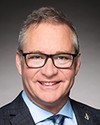That's a really promising area, one that, I think, makes us feel the urgency. We feel like we're a pretty quick-moving company, but we really feel the demands of the time to jump in and help as much as we can.
Traditional telemedicine has been to connect a hospital or a clinic so that doctors can talk to each other and can consult and access, as you say, specialized, experienced medical professionals.
There are two things that we're seeing now.
One of them is in sort of escalating that sophistication. I've been talking to groups that are doing online surgeries using this kind of distanced access for telehealth, which certainly puts a lot of emphasis on reliability and on latency.
Because our satellites are so close to the earth—they're about 550 kilometres above the earth's surface—the ping to go to the satellite app is less than 40 milliseconds. That's less than what most 5G systems are going to be targeting. It's a viable platform for time-sensitive things, not just a teleconference with your doctor but increasing time-sensitive applications.
The other thing that's happening is that, instead of connecting the clinic or the hospital, increasingly health care providers want to connect the home. They don't want their patient during the course of care to come in, so it's pushing the connectivity out to a residence, even if just for a short period of time during the course of treatment.
We've been looking at these with various telemedicine groups and clinics, and I think there's a lot of promise there.





